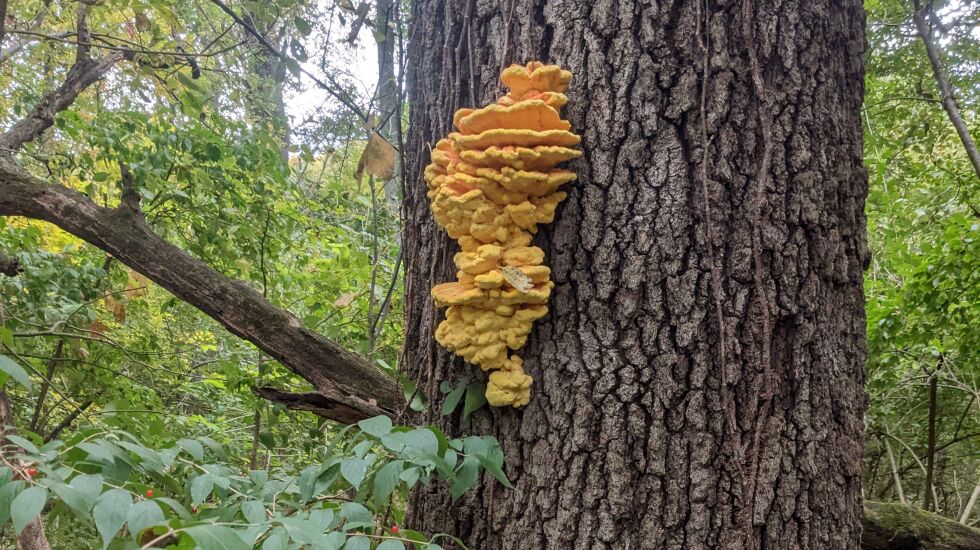
Master naturalists/master gardeners milled around last week before a seminar on fall foraging. When the leader didn’t show because of a scheduling snafu, we rambled off for a couple hours as a group.
We swapped tidbits about boneset tea and the dyeing properties of pokeweed berries. That inspired me to do my rendering of Tony Joe White’s biggest hit, “Polk Salad Annie.” My guttural non-verbal utterances drew on the best of Terry Boers on The Score.
Our first good find was a puffball, so dried out that a touch elicited a puff of spores. Next was a chicken of the woods mushroom, stunningly fresh considering the dryness for weeks. Between the dryness and the frost/freeze last weekend, it’s been tough for mushrooms.
So I checked with Andy Miller, curator of fungi for the Illinois Natural History Survey.
“Many fall mushrooms produce larger fruiting bodies than the spring morels, and thus require more moisture,” he replied. “The recent dry spell will certainly reduce the number and size of our favorite fall mushrooms such as chicken-of-the-woods, hen-of-the-woods, and oyster mushrooms. An early freeze like we have recently experienced will also reduce the number of fall mushrooms, but if it warms back up again and we receive some rainfall, they should continue to produce fruiting bodies.”
The rains Tuesday and Wednesday should help.

Next we found a woolly bear, very late for my first sighting of the year.
That inspired me to ask Illinois state biologist Eric Schauber if anybody at the INHS was working on woolly bears or anything on the folklore of their winter forecasting.
“No, we haven’t had anyone specifically working on woolly bears, but our entomologists point to the `authoritative source on the topic’ by May Berenbaum,” he replied.
That would be Berenbaum’s “Entomological bandwidth” (doi.org/10.1093/ae/54.4.196). After reading, I highly recommend it for those interested in the folklore of woolly bears.
“Probably the last attempt to investigate the scientific basis of the meteorological predictive powers of the banded woollybear was launched by Charles Curran of the American Museum of Natural History,” Berenbaum noted in the article. “Beginning in 1947, he conducted a series of experiments attempting to correlate band width with winter severity, but abandoned this work in 1955, concluding that the correlation was predictive about half the time (making woollybears about as successful in predicting winter weather as contemporary meteorologists).”

I wander all over the greater Chicago area. This fall I noticed extra colorfulness of maples, especially the red and sugar maples.
Christy Rollinson, forest ecologist at The Morton Arboretum, agreed, “Maples seem to be having a particularly spectacular year. At The Morton Arboretum, we’re doing more photography-based monitoring so we can better quantify the intensity of the color changes, not just the timing, but we don’t have that data yet to say exactly how much more vibrant these trees are. Many other places, such as New England, are also showing particularly bright color this year.
“There is still a lot to be learned about what controls the timing and intensity of fall color, but in general, vibrant fall color is a sign of a good growing season, healthy trees, and a sunny fall — all of which we’ve had this year.”
As to the vibrant reds, Rollinson noted, “The bright sunlight of the past few weeks will promote the production of red pigments (anthocyanins) that are characteristics of not just maples, but Virginia creeper and poison ivy as well. Trees that have these two vines wrapped around their trunks have been particularly noticeable this year.”
It’s a fall to notice.







